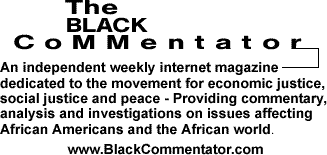Bill Moyers and
Charles Rangel have called upon America�s
leaders to reinstate the military draft. The call reflects a moral imperative
that the burden of actual fighting in America�s foreign wars be shared more equally
across the American class structure. African Americans, over-represented
among the American poor, are over-recruited into the armed forces by the
�poverty draft.� In the so-called �post-civil-rights� moment disparate
impact in dying for one�s country on the axes of class and race should
not be tolerated. This is the African American stake in the American war
in Afghanistan
policy debate. I call it the American war because the United States is the prime
mover in Operation Enduring Freedom-Afghanistan, the International Security
Assistance Force (�ISAF�), and United Nations efforts there.
Former National
Security Advisor to President Jimmy Carter, Professor Zbigniew Brzezinski
is credited with the idea of the �Afghan Trap.� By this he meant an unwinnable
�Vietnam War� for the now former Soviet Union that
then was under the rule of Leonid Brezhnev. In summer 1979, the Carter
administration started giving logistical support to Afghan resistance
to a Soviet-allied Afghan government to increase the likelihood of a Soviet
military invasion. In December 1979 the Soviet invasion and occupation
followed. In February, 1989, after over 14,000 military personnel died,
the Soviet Union withdrew.
Reagan era U.S.
cold warriors saw the Soviet occupation from 1979 to 1989 as an opportunity
to beat the �Reds� by �liberating� Afghanistan.
In the Soviet period, they contracted Pakistan�s intelligence services to provide military,
logistical, and to pass through financial support to the Afghan resistance.
Among the foreign Islamic fighter groups against Soviet communism, one
sponsored by former Saudi national Osama bin Laden also gave ideological
support and later became Al Qaeda. The local and foreign fighters learned
well how to conduct an internationally supported, locally-based armed
insurgency against the occupation.
Mullah Mohamed
Omar, an Arabic-speaking Pashtun who later became a religious teacher,
was among those who fought in this proxy war against the Soviet
Union. He is presently considered the most effective of the insurgency�s
leaders. Today�s resistance fighters probably receive operational training
primarily from Soviet period Afghan mujahideen veterans.
Following the Soviet
Union�s withdrawal in 1989 and the end of the Cold War, the U.S.
disinvested from both Afghanistan
and Pakistan.
During the fight anti-Soviet foreign aid built up the regional radical
Islamist movement. Osama bin Laden returned to Saudi Arabia in 1989 but was expelled in 1991
for anti-government activities. He objected to American troops being stationed
in his country after Iraq�s
1990 invasion of Kuwait.
He moved to Sudan where
he began developing operations against the U.S. presence in the region.
In Afghanistan in 1992, three years after the Soviet
withdrawal, the formerly Soviet-backed Najibullah government fell as the
country plunged into civil war. Pakistan
and Saudi Arabia, the
former U.S. allies
in the anticommunist crusade, and later the United
Arab Emirates, Russia,
and Iran, until 2001
supported various armed factions in Afghanistan.
Mullah Omar in
1994 apparently started a new military effort with some fifty armed religious
students. The Afghan Taliban grew as they fought in the civil war against
the regional warlords until 1996, when they took over Kabul
and the central government, and thereafter. Omar�s religious conservative
Islamists established a male supremacist, religious law based regime.
In summer 2000 the Taliban banned opium poppy cultivation. By February
2001 U.N. observers declared the religious militia had wiped out opium
production in a country that once was and today is once again the world�s
largest producer.
The prior Soviet
era connection with transnational Islamic fighters led Mullah Omar�s government
to provide safe haven for Osama bin Laden and Al Qaeda when in 1996 it
was driven out of the Sudan. Al Qaeda in Afghanistan
planned and began executing further foreign operations including the September
11, 2001 attacks. On August 6 this year John Brennan, Senior White House
Advisor for Homeland Security and Counter-Terrorism, said: �Al Qaeda has
proven to be adaptive and highly resilient and remains the most serious
terrorist threat we face as a Nation.�
In October 2001
the United States invaded Afghanistan but failed to follow through to destroy
the Al Qaeda organization. This led directly to Afghan war policy conundrums
that the Obama administration today faces. Afghans, particularly the Pashtuns,
thirty years and under have known only warfare and have limited employment
options. The Afghan refugee crisis doubtless reflects how few now can
even imagine a peaceful and prosperous Afghan nation.
Complicating the
situation is an uncertain and nuclear-armed ally, Pakistan,
and the Pakistan government�s
long-term welfare dependency on U.S. foreign and military aid. Pakistan itself now faces
a Pakistani Taliban insurgency as it seizes the northern areas it allowed
Afghan fighters to use as a base for some of their Afghan combat operations.
If the United States
experienced blowback in the 1998 Kenya
and Tanzania embassy
bombings and on September 11, 2001, Pakistan
now faces blowback for its own state sponsorship of terrorism as an instrument
of its foreign policy.
Afghan resistance
has recently resurged, under three primary fighting groups that are funded
by foreign donations and drug trade revenue. America�s
adversaries in Afghanistan
are led by an Afghan leadership principally based in Pakistan. Among these is Mullah Omar�s organization
in the Quetta Shura Taliban in southern Pakistan. Afghan combat operations
however decline in winter reflecting a seasonal fighting cycle.
For unemployed
Afghan youth from within the country or from the Afghan refugee camps
in Pakistan, the armed struggle
may be the only available paid employment outside the drug trade. The
net effect of this and America�s
poverty draft is that America�s
underprivileged youth of all colors end up fighting the Afghan refugee
poor.
Commander Osama
bin Laden, while he initially denied it, and his Al Qaeda leadership team
conceptualized the spectacular (it was a global spectacle) World Trade Center
and Pentagon attacks. Their purpose was to draw the United States � their version of the �Evil Empire�
� into a new �Afghan Trap.� While some doubt the story, it is the global
elite consensus view. Bin Laden, while never formally Zbigniew Brzezinski�s
student, thus understood and learned well the master�s Afghan Trap concept.
Bin Laden hoped for and intended a new Vietnam War for the United States. In this sense,
then, he is Brzezinski�s star pupil.
The present U.S. strategy and troop levels
debate represents reaction to the Afghan Trap. The U.S. assessment seems to embrace both more troops
and a counterinsurgency approach that requires building linguistic and
cultural competence among U.S.,
British, and ISAF forces operating in Afghanistan. The intent is not only to provide
physical security to the Afghan people, but to use the soldiers to build
capacity both for Afghanistan�s
economic development and for transparent local, regional, and national
governance. This is a clear rejection of the Bush administration�s �no
nation-building� stance. It also responds to what was long an open secret
and is now public, the Karzai government�s corruption by the expanded
narcotics trade that itself contributes to Afghan popular disillusionment
and ultimately resistance.
Afghan nation-building
by foreigners is a bit contradictory. Moreover, at a time when the U.S. government is already deficit spending its
way out of recession, it will be expensive. There is a proposal to build
up the Afghan National Security Force � the army, air force, and police
� to some 400,000 strong. Optimum for financing this, and simultaneously
eliminating the drug corruption problem, could be international decriminalization
of opium and marijuana production and consumption. Afghanistan could tax the
production to generate much-needed revenue for its governmental operations.
Overdeveloped nations could use a harm reduction approach to consumption
and provide suitable markets. This is arguably a conservative restoration
approach. Global opium and marijuana legalization would merely return
us to the mid-nineteenth century regime of free trade. For the U.S., the benefits of such free trade now clearly
outweigh the costs.
BlackCommentator.com
Guest Commentator, John Hayakawa T�r�k, is a
critical race theorist and card-carrying member of the USA
Green Party, who lives in Oakland,
California. He is a Fellow, World Association of International
Studies, Stanford University.
Click here
to contact John T�r�k.
|



